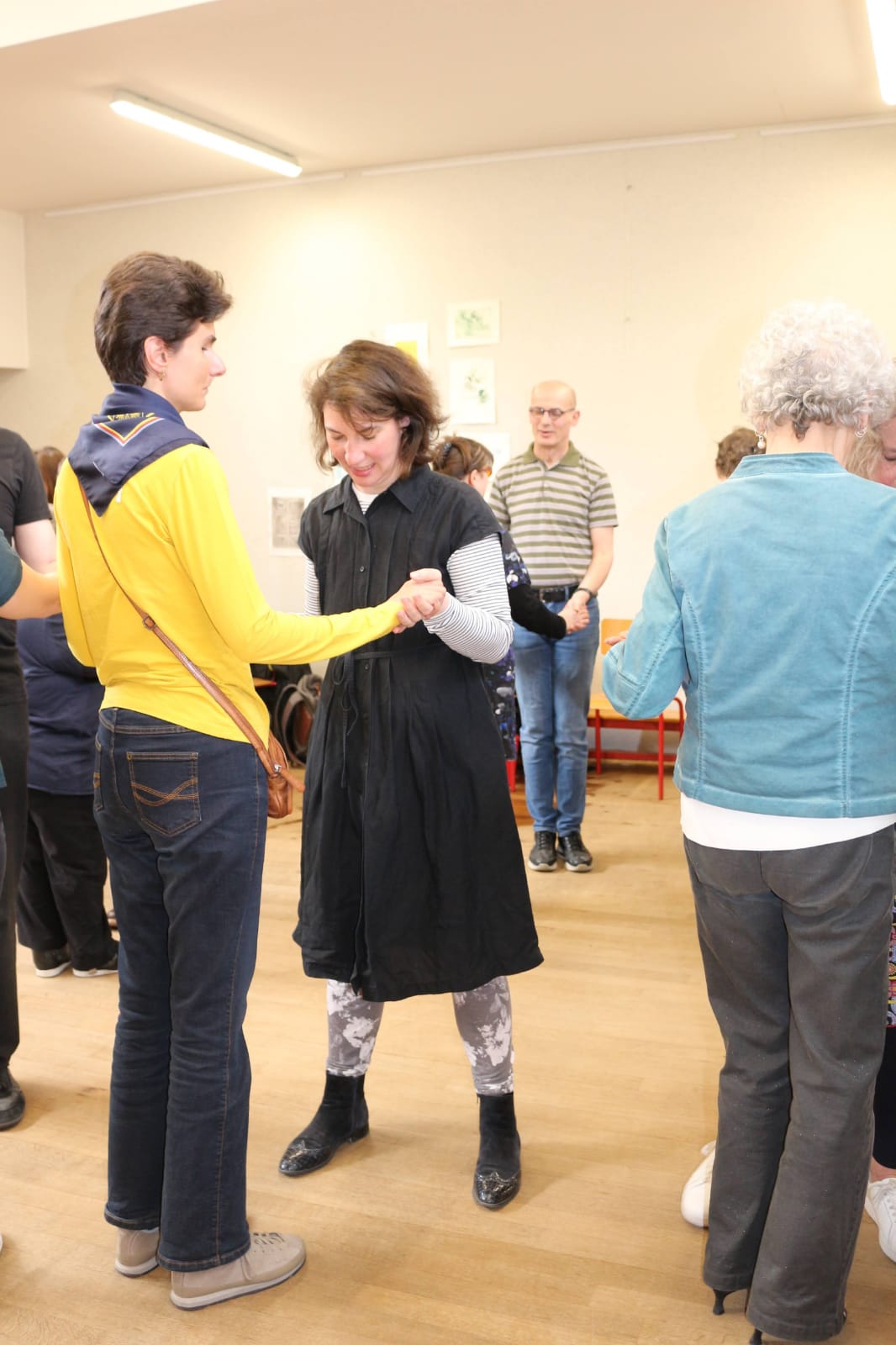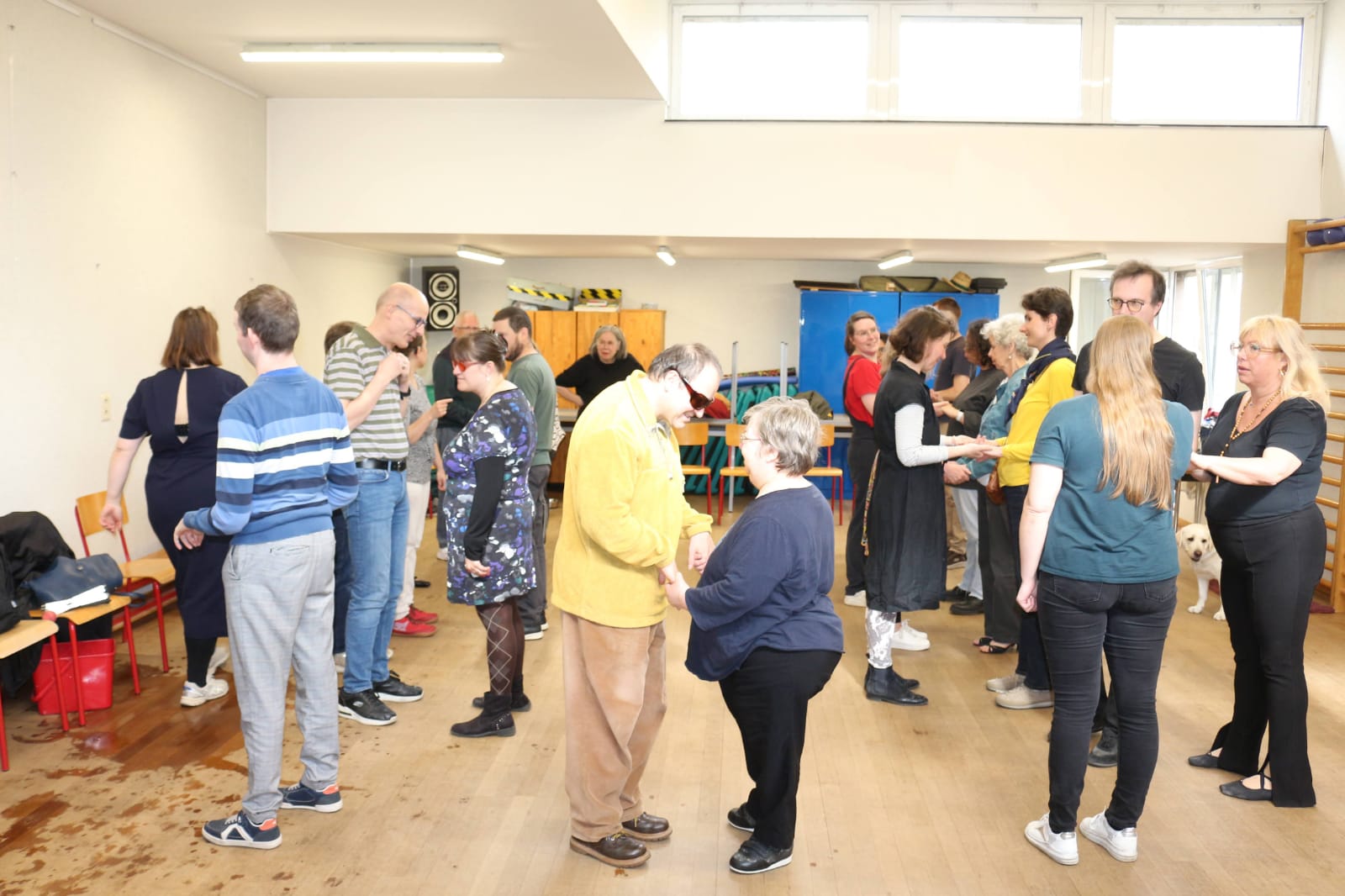Tactile and proprioceptive orientation in dancers with a visual impairment: a somatic approach to movement behavior
A somatic approach (derived from the Greek sōma, meaning "body") starts from the inner bodily experience, rather than the outward image of a movement. In this approach, the focus is not on how a movement looks, but on how that movement is experienced from within. I often say in interviews: if something feels good, if the movement feels good, then the visual aspect gets a less important aesthetic value. Value determination through feeling and not (only) through the visible.
In practice, this means that considerable attention must be paid to elements such as body awareness, breathing, proprioception (feeling the position of one's body in space), and interoception (perceiving internal sensations like muscle tension, relaxation, or breathing rhythm).
Instead of striving for a visual ideal image or imitating movements, the dancer is invited to explore, feel, and trust internal signals.
Tips for teachers: instead of saying “Do it like I demonstrate,” say “Keep your arm straighter.”
You can also ask: “When you lift your arm, how does this movement feel in your back depending on the straightness of your arm?”
For dancers with a visual impairment, this approach is particularly relevant. In the absence of visual feedback, a somatic approach provides a safe, respectful, and experience-based framework to learn movement. It supports the development of self-confidence, freedom of movement, and body awareness, thus forming a valuable foundation for inclusive dance pedagogy.
Body awareness is a significant challenge. These are the observations I made:
1. Body awareness and overcompensation in dancers with a visual impairment
When working with dancers with a visual impairment, it is often noticed that movements are accompanied by excessive muscle tension, increased speed, and exaggerated motor expression. These movements are often not the result of a lack of motor skill, but of an attempt to meet a visual ideal image that the dancer cannot perceive themselves.
In practice, this means that a dancer may excessively raise their shoulders, press their head into the torso, or curve their back when asked to perform a specific movement. The movement becomes stiff, abrupt, and tense — as if the dancer is trying to ‘show’ that they are moving, without actually being in touch with the inner feeling of that movement.
This behavior can be understood as a form of overcompensation. In the absence of visual feedback, the body uses other strategies to gain certainty: increased muscle tension, a larger range of motion, and accelerated execution. While understandable, this often leads to inefficient, unbalanced movement patterns and reduced body coordination.
For the teacher or guide, it is important to recognize these signals — not as mistakes, but as valuable information about the dancer's internal orientation. The goal is not to slow down movements but to shift the focus from the appearance of the movement to the inner experience of it. This requires a methodology in which breath, proprioception, tactile feedback, and rest are central. By guiding the dancer in developing internal body awareness, space is created for more fluid, balanced, and organic movement quality.
2. Body awareness and hesitant movement in dancers with a visual impairment
Not all dancers with a visual impairment respond to uncertainty with overcompensation or tense expression. In practice, the opposite behavior is also common: movements that are small, withdrawn, and extremely cautious. Steps are minimized, arm movements stay close to the body, and the overall movement quality is reserved or minimal.
This hesitancy is not a sign of unwillingness or incapacity, but should be understood as a protective strategy. When visual information is absent, there is uncertainty about the space, the position of the body within it, and the safety of the environment. To maintain control, the body minimizes its range of movement.
Additionally, proprioceptive uncertainty plays a role: when the sense of one’s body position in space is not sufficiently developed, it is difficult to make large or expressive movements with confidence. Some dancers also limit their movements due to psychological hesitancy, such as fear of failure, shame, or the desire not to disturb or stand out within a group. The nervous system can also play a role here. When the body feels unsafe, it responds with inhibition and tightening — often unconsciously.
Case example: closed arm position
A common observation is that dancers keep their arms tightly against their bodies, with elbows pushed back, close to the torso. In this position, the upper body posture remains closed, breathing is restricted, and the freedom of movement of the shoulders and arms is limited.
When such a posture is maintained for a prolonged period, a tense, inhibited movement language develops. This behavior is usually not learned from technique, but stems from uncertainty: the dancer does not know where the arms "should be" and opts for maximum control — close to the center of the body.
This behavior is linked to the neuroceptive system, where the body continuously scans for safety. In unfamiliar environments without visual confirmation, the body goes into “protection mode.”
Hesitant movement also arises from reduced kinesthetic confidence: the lack of certainty about where the body is in space leads to minimization.
Possibly also psychological: social inhibition is more common in people with a visual impairment who were raised in protected environments or are less accustomed to free body usage.
For the teacher, the challenge in such contexts is: we do not simply correct (“bring your arms forward”), but look for tools and ways to build body awareness and trust in the visually impaired dancer.
The key lies in creating trust in the body without visual confirmation. This therefore requires not only a pedagogical adjustment but also a different view of what dance quality means: the aesthetic ideal needs to be redefined, based on presence, embodied experience, and internal coordination.
Image and video Decription
photo 1: Analysis of Posture in Blind and Sighted Dancers. On the image, a striking difference in body awareness can be observed between blind and sighted dancers during the execution of the same dance task. The blind woman in the foreground, wearing a yellow sweater, demonstrates a notably straight and tight posture with her feet placed close together. In contrast, the sighted woman, who performs the same task, stands with a wider, more open stance and generally a looser posture. This difference suggests a variation in body orientation and proprioceptive awareness between the two dancers.
In the background, there is also a man with glasses, who is also blind. He displays a similar closed posture as the previously mentioned blind woman. The similarity in physical expression between the blind participants points to the influence of visual input on motor behavior and spatial orientation within a dance context. Despite the smaller and more closed movement patterns visible in the blind dancers, it is notable how strongly they strive for correct posture. The straight back and controlled tension in the body testify to great commitment, body awareness, and discipline. This certainly deserves a big compliment – it shows that dance, regardless of visual ability, remains a powerful medium for expression and refinement of movement.photo 2: During an exclusive dance class, mostly consisting of dancers with a visual impairment, a notable pattern in body posture was observed in a photo. A significant number of visually impaired and blind participants display a pronounced hunched posture while dancing. Although visual impairments may affect spatial orientation and postural control, correct posture – particularly a straight and extended spine – remains essential in dance practice. A bent or hunched back can have various detrimental effects, both in the short and long term. Biomechanically, a curved spine leads to uneven pressure on the intervertebral discs, which increases the risk of back pain and muscle fatigue. Additionally, a slumped posture can restrict breathing by reducing the thoracic space, which in turn impacts breath control and physical endurance during dance movements. Also, on an artistic level, a hunched back impedes expressiveness, body projection, and presence, which are essential in performative disciplines such as dance.
photo 3: Michèle dances with a lady in a yellow sweater
video 1: Tactile Movement Exploration on the Floor: A Study on Spatial Safety for Dancers with a Visual Impairment. As part of a tactile movement exploration, an exercise was conducted under the guidance of Frank Van Neerboom – choreographer, dance friend, and former finalist of So You Think You Can Dance. In this exercise, inspired by principles from contemporary dance, Van Neerboom guided Manuel in performing large, flowing movements in a low dance technique on the floor. The goal of this session was to explore to what extent the dance floor can offer a sense of safety to dancers without visual reference, and how this confidence can promote the execution of larger, more spatial movements. The floor thus functions not only as physical support but also as a tactile information source, allowing the dancer to develop orientation and movement freedom through direct bodily feedback. From a motor and sensory perspective, floor dancing offers various benefits for dancers with a visual impairment. The constant contact with the ground reduces the risk of losing balance and increases the sense of stability. Additionally, proprioceptive signals – such as pressure, weight transfer, and contact points – can be interpreted more efficiently when moving horizontally rather than vertically in space. This approach opens up possibilities for the development of adapted methodologies within inclusive dance practices, where the floor functions not only as a surface but as an active partner in the spatial and choreographic exploration of the dancer.
video 2: Dance as a Bridge Between Worlds: Sensitization and Integration through an Inclusive Bachata Workshop. Michèle was invited by students from the University of Ghent to lead a bachata workshop. For this occasion, she brought Manuel with the aim of introducing him to these fine young people. The goal of this workshop went beyond just dance technique: it aimed at deeper sensitization and mutual integration between people with and without visual impairments. On one hand, Manuel – by actively participating – was exposed to a new social context, where young people were the focus. On the other hand, the participating students had a unique opportunity to approach dance from a different perspective, where tactility, alignment, and non-visual communication are essential. Michèle acted as a tactile reference for Manuel in this context, with her body serving as a guide and structure within the dance experience. In a subsequent assignment from the University of Brussels, two physiotherapy students were invited to observe during a similar dance session. Their task was to analyze the movement behavior and motor adaptations of the participants from a physiotherapeutic perspective. In their report, they describe the following: ICF model: Functions/ Anatomical properties: Issues with torso mobility, fine motor skills due to visual dysfunction. Activities: Difficulty with independent dancing, especially with fast rhythms and without guidance. Participation: Performs well when dancing with Michèle. External factors: The sound system is moved in the space to support orientation, use of ballet stick as a tool.


